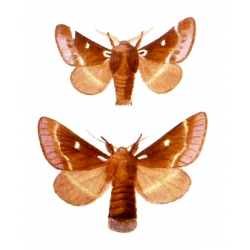- Current EGGS and LARVAE (54)
- EXOTIC BUTTERFLY PUPAE (11)
- MARKET STALL Everything a BARGAIN! (22)
- XXP super fast EXPRESS COURIER DELIVERY (2)
- CURRENT PUPAE - Chrysalides and cocoons (45)
- SILKWORM EGGS and Silkworms (6)
- SPRING and SUMMER EGGS and LARVAE Order now for supply in season (73)
- SPRING and SUMMER PUPAE You can order these NOW in advance (25)
- GIFT SUGGESTIONS (29)
- WINTER PUPAE for breeding in the following season (30)
- CAGES (10)
- PHASMIDS Leaf & Stick Insects, Mantids and more (2)
- SCHOOLS Recommended Livestock (14)
- SLEEVES for REARING LARVAE (7)
- PLASTIC REARING CONTAINERS (2)
- EQUIPMENT (29)
- MOTH TRAPS (7)
- NETTING (3)
- BOOKS (39)
- CHARTS (21)
- SPECIMENS for collectors (151)
- SILK Yarn, Fibres, Silkworm eggs (7)
Small Eggar Moth Eriogaster lanestris
The moths emerge in March/April. On receipt of the pupae they should be refrigerated until spring. The moths form inside the cocoon in late winter. The moment the temperature rises, they burst forth, and it is inadvisable to let them do this too early, or any fertile eggs might hatch before there is any foodplant.
Because of modern practice of hedge management, this once common species is nowadays a rare find. Tight clipping of hedges destroys the habitat and undoubtedly the eggs and larvae.
Egg clusters are laid in batches, covered with black fluff from the tip of the female's abdomen, on branches of the foodplant Blackthorn Prunus spinosa or Hawthorn Crataegus monogyna. The larvae cluster, and even large larvae live within, and on the outsite of a prominent white tent of silk, very often at the end of a branch, with no attempt at concealment. It is likely that the larvae in captivity could be reared on Apple and Plum, though we have not tried these.
Don't be tempted to handle the larvae. They have short, decorative hairs, which easily come away and if they penetrate the skin, like short cactus prickles, this can give rise to intense irritation. No doubt this is why the larvae can afford to display themselves in the wild so openly. No predator will try to eat them once they learn, and the larvae are patterned in warning colours to advertise the danger.
To pupate, the larvae descend to form a tight cocoon with a smooth shell-like a nut, in concealed leaf litter or moss, where they spend the winter. In early spring, the moths are fully formed within the pupal shell, ready to emerge the moment they sense that conditions are right. If you take the nut-like cocoons from the cold and put them into room temperature, the moths will suddenly break open the ends of the cocoons and there will be a whole lot of moths in a very short time!
You might help to spread the species locally if you can find thorn hedges that are not regularly trimmed. Cocoons are immediately available. Keep them in the fridge until April. You will enjoy observing this species, in all its interesting stages, and maybe could introduce it to your area.












